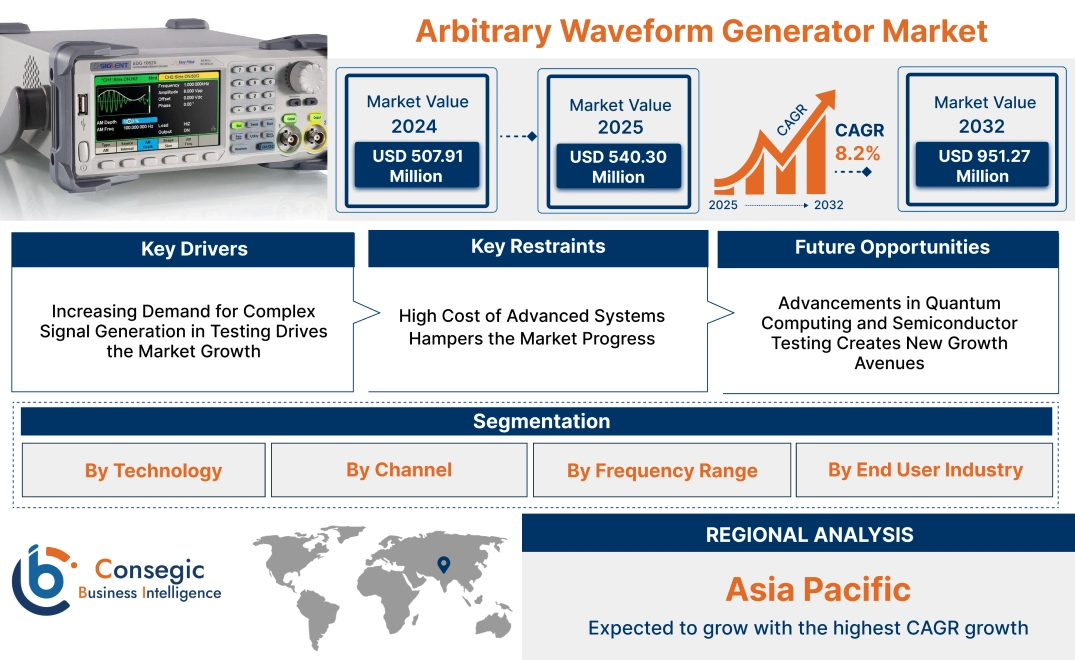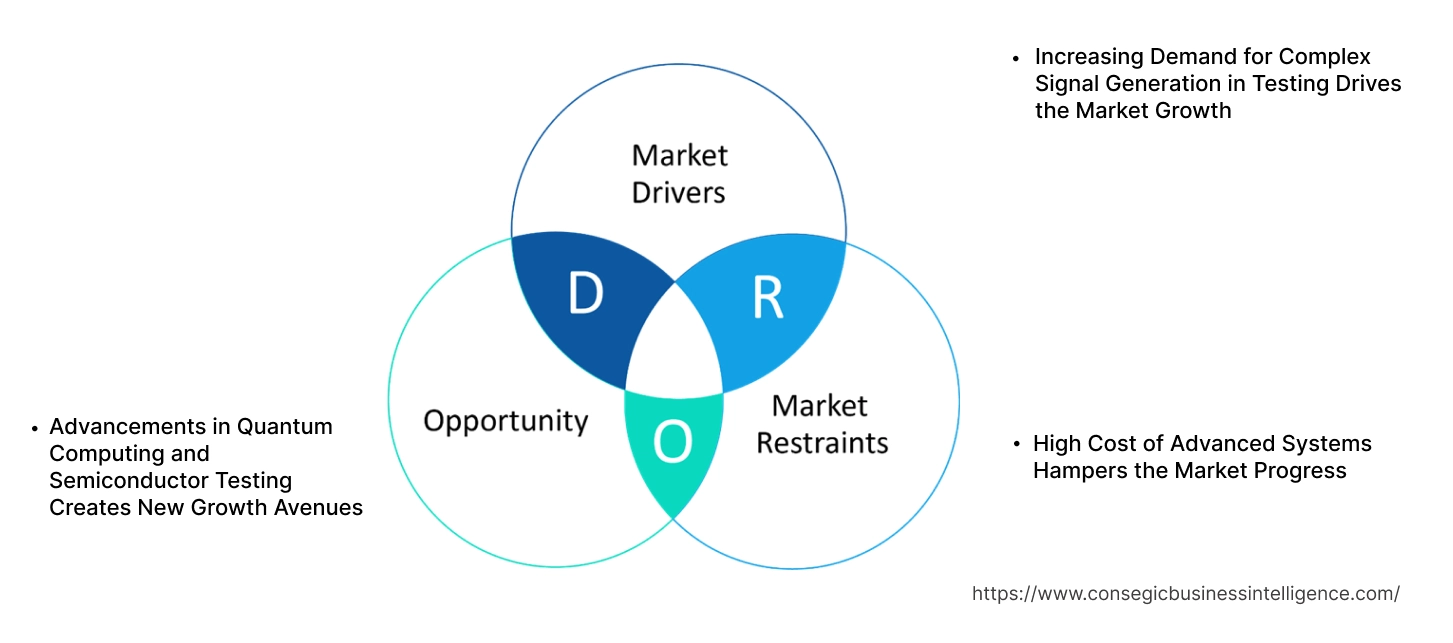- Summary
- Table Of Content
- Methodology
Arbitrary Waveform Generator Market Size:
Arbitrary Waveform Generator Market size is estimated to reach over USD 951.27 Million by 2032 from a value of USD 507.91 Million in 2024 and is projected to grow by USD 540.30 Million in 2025, growing at a CAGR of 8.2% from 2025 to 2032.
Arbitrary Waveform Generator Market Scope & Overview:
An arbitrary waveform generator is a specialized electronic test instrument used to generate custom waveforms and signals for testing and design purposes. These devices are widely utilized in industries such as telecommunications, aerospace, defense, and electronics manufacturing to simulate real-world signals and verify the performance of electronic systems. They are designed to deliver precise and flexible signal generation for a variety of applications.
These generators are equipped with features like high resolution, multi-channel outputs, and advanced modulation capabilities to meet complex testing requirements. They support the creation of waveforms such as sine, square, triangle, and custom shapes, ensuring versatility in test setups. Additionally, they integrate with software tools for waveform editing and real-time control, providing enhanced usability and efficiency.
End-users include research institutions, electronic design engineers, and testing facilities requiring reliable and customizable signal generation for product development and validation. Arbitrary waveform generators play a crucial role in enabling accurate testing and efficient development of advanced electronic systems.
Key Drivers:
Increasing Demand for Complex Signal Generation in Testing Drives the Market Growth
The growth in demand for advanced testing solutions in industries like telecommunications, aerospace, automotive, and consumer electronics is driving the need for devices capable of generating complex signals. Arbitrary waveform generators (AWGs) play a crucial role in this demand by simulating highly specific waveforms required for product development and testing. In telecommunications, AWGs help test communication equipment by generating signals that replicate real-world network conditions. In aerospace, they are used to simulate radar, sensor, and communication signals, ensuring the functionality of critical systems. The automotive industry relies on AWGs for testing electronic control units, sensors, and autonomous vehicle systems. Similarly, in consumer electronics, AWGs are used to validate the performance of next-generation devices, such as smartphones and wearables, by providing precise signal simulations. By enabling the creation of custom waveforms for diverse applications, AWGs contribute to enhancing product quality, performance, and reliability across multiple industries. Thus, the above factors are fueling the arbitrary waveform generator market growth.
Key Restraints:
High Cost of Advanced Systems Hampers the Market Progress
A significant restraint in the adoption of advanced waveform generators is the higher cost compared to basic function generators. Due to their advanced capabilities, including the ability to generate complex and customized waveforms, these systems tend to be more expensive. This higher upfront cost is a barrier for small businesses, research institutions, or industries with limited budgets. While the benefits of advanced testing, precision, and flexibility offered by these generators are clear, the initial investment required is not justifiable for all users, especially those with more straightforward testing needs. For sectors where basic waveforms suffice, opting for simpler and more affordable function generators is seen as a more cost-effective solution, limiting the market penetration of advanced waveform generators in certain price-sensitive applications. This cost factor hinders the arbitrary waveform generator market demand, particularly in emerging industries or regions with budget constraints.
Future Opportunities :
Advancements in Quantum Computing and Semiconductor Testing Creates New Growth Avenues
Advancements in quantum computing and semiconductor technologies are creating a growing need for precise testing tools to ensure the performance and reliability of these complex systems. Arbitrary waveform generators (AWGs) are essential in testing quantum chips and semiconductor devices, as they are capable of producing highly accurate and custom waveforms required to simulate real-world operating conditions. In quantum computing, AWGs are used to test qubits, ensuring proper functionality and coherence by generating precise signals. Similarly, in semiconductor testing, AWGs help validate the behavior of intricate circuits by mimicking the required signal inputs and conditions. As these technologies continue to evolve, the need for high-performance, versatile testing equipment will increase, positioning AWGs as a crucial tool in the development and optimization of quantum and semiconductor devices. This presents significant arbitrary waveform generator market opportunities, particularly in these cutting-edge fields.
Arbitrary Waveform Generator Market Segmental Analysis :
By Technology:
Based on technology, the market is segmented into Direct Digital Synthesis (DDS) AWG, Variable-Clock AWG, and Combined AWG.
The Direct Digital Synthesis (DDS) AWG segment accounted for the largest revenue of the total arbitrary waveform generator market share in 2024.
- DDS AWGs are highly favored for their precision and ability to generate complex waveforms with low phase noise, making them essential for applications in telecommunications and electronics.
- Their efficiency in producing highly accurate and stable frequencies supports their adoption in signal simulation and functional verification tasks.
- DDS technology offers significant advantages in terms of frequency agility, making it ideal for research and development in areas such as 5G and advanced wireless communication systems.
- As per arbitrary waveform generator market analysis, the integration of DDS AWGs into advanced testing equipment reflects ongoing trends toward improving signal fidelity and testing accuracy in high-frequency domains.
The Combined AWG segment is projected to grow at the fastest CAGR during the forecast period.
- Combined AWGs offer the benefits of both DDS and variable-clock architectures, providing users with the flexibility to switch between fixed and variable frequencies.
- These systems are increasingly used in multifunctional applications such as functional verification and signal simulation for automotive and aerospace sectors.
- The need for versatile testing equipment in industries requiring a broad frequency range has driven the adoption of combined AWGs.
- Their ability to cater to both research and production environments enhances their appeal across various end-user industries, contributing to the arbitrary waveform generator market expansion.
By Channel:
Based on channel, the market is segmented into single channel and dual channel.
The dual channel segment accounted for the largest revenue of the total arbitrary waveform generator market share in 2024.
- Dual-channel AWGs allow for simultaneous generation of two independent signals, making them indispensable for applications like differential signal testing and advanced signal analysis.
- These systems are widely adopted in industries like telecommunications and aerospace, where multi-signal generation and synchronization are critical.
- Advancements in dual-channel technology, including higher bandwidth and improved synchronization accuracy, support their widespread adoption in complex testing scenarios.
- As per the arbitrary waveform generator market trends, the increasing use of dual-channel AWGs in applications requiring phase-coherent signals aligns with market trends in advanced electronics testing.
The single channel segment is projected to grow at the fastest CAGR during the forecast period.
- Single-channel AWGs are highly preferred for applications requiring precise waveform generation, particularly in functional verification and signal integrity testing.
- These systems are cost-effective and simpler to operate, making them ideal for basic research and educational purposes.
- Their compact design and lower power consumption further enhance their suitability for laboratories and small-scale operations.
- The continued demand for single-channel systems in niche applications ensures their relevance across multiple industries, fueling the arbitrary waveform generator market growth.
By Frequency Range:
Based on frequency range, the market is segmented into up to 1 GHz, 1 GHz to 5 GHz, and above 5 GHz.
The up to 1 GHz segment accounted for the largest revenue of 57.6% share in 2024.
- AWGs in this frequency range are extensively used for low-frequency applications such as audio testing, basic circuit analysis, and educational research.
- Their affordability and ease of use make them a popular choice for small-scale industries and academic institutions.
- These systems are ideal for generating standard waveforms like sine, square, and triangular signals, supporting their adoption in various functional testing applications.
- The segment benefits from ongoing technological improvements, including better frequency stability and signal accuracy, enhancing their utility in foundational research, further driving the arbitrary waveform generator market demand.
The above 5 GHz segment is projected to grow at the fastest CAGR during the forecast period.
- High-frequency AWGs are critical for advanced applications in telecommunications, aerospace, and defense, where ultra-high frequencies are essential for testing next-generation systems.
- These systems are widely adopted in signal simulation for 5G networks, radar systems, and satellite communication equipment.
- The integration of advanced technologies such as phase-coherent generation and real-time waveform editing ensures their effectiveness in high-frequency testing scenarios.
- As per arbitrary waveform generator market trends, the growth in focus on developing high-performance communication systems drives the adoption of high-frequency AWGs in this segment.
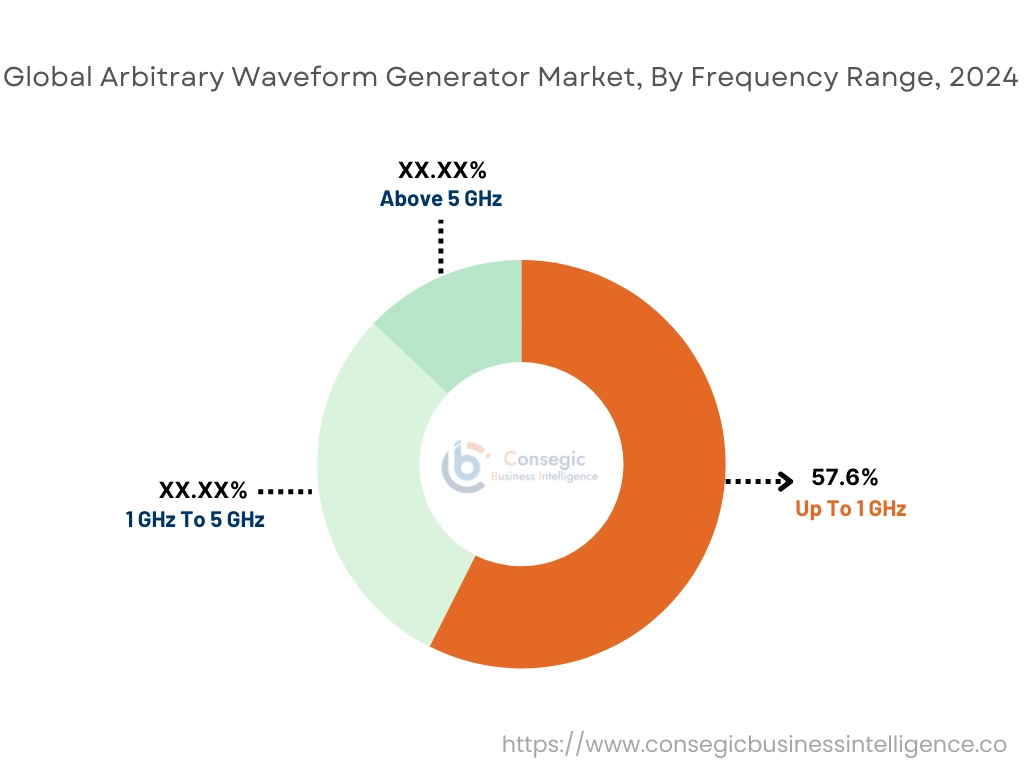
By End-User Industry:
Based on end-user industry, the market is segmented into telecommunications, electronics, automotive, aerospace & defense, healthcare, and others.
The telecommunications segment accounted for the largest revenue share in 2024.
- Arbitrary Waveform Generators are extensively used in the telecommunications industry for signal simulation, testing network components, and verifying communication protocols.
- The deployment of 5G networks and advancements in wireless technologies have significantly driven the adoption of AWGs for high-frequency signal testing.
- These systems enable precise waveform generation and modulation, ensuring reliable performance in complex telecommunication networks.
- As per arbitrary waveform generator market analysis, the emphasis on achieving high data transfer rates and low latency in modern networks supports the dominance of this segment.
The aerospace & defense segment is projected to grow at the fastest CAGR during the forecast period.
- AWGs are critical in testing radar systems, navigation devices, and electronic warfare equipment, ensuring their accuracy and reliability in demanding conditions.
- The aerospace sector relies on high-performance AWGs for simulating complex signals in satellite communication and avionics testing.
- Increasing investments in defense modernization programs and the development of next-generation aerospace systems contribute to the growing need for AWGs in this segment.
- Their ability to handle high-frequency signal generation with minimal distortion aligns with the stringent requirements of the aerospace and defense industries, contributing to the arbitrary waveform generator market expansion.
Regional Analysis:
The regions covered are North America, Europe, Asia Pacific, the Middle East and Africa, and Latin America.
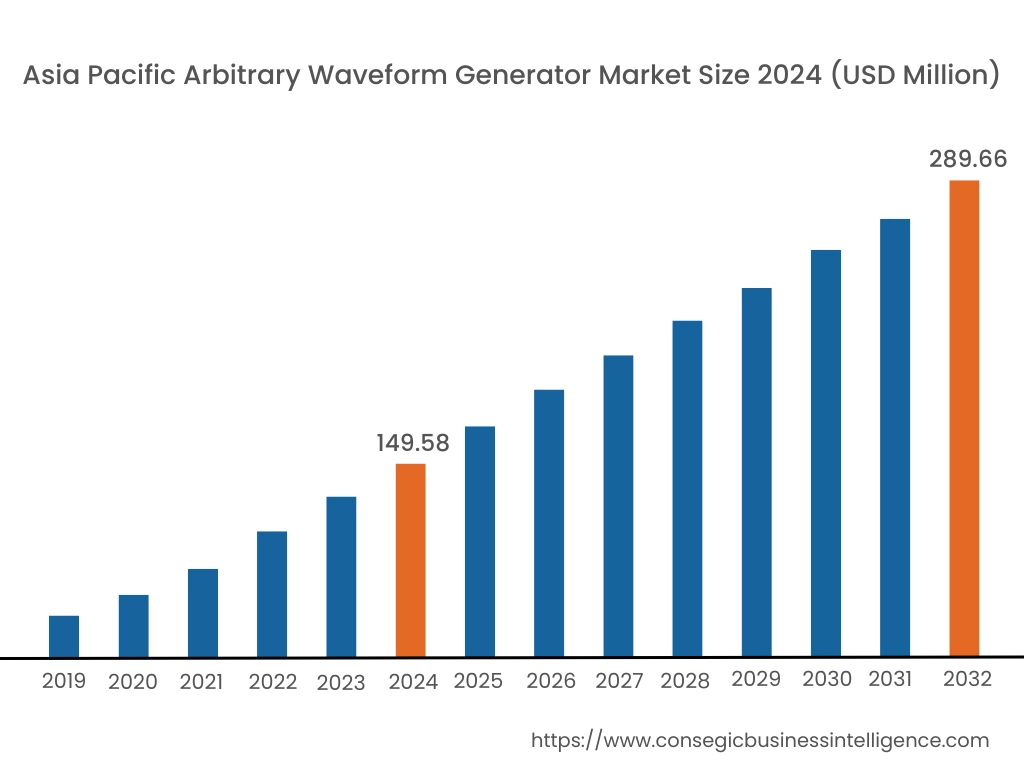
Asia Pacific region was valued at USD 149.58 Million in 2024. Moreover, it is projected to grow by USD 159.57 Million in 2025 and reach over USD 289.66 Million by 2032. Out of this, China accounted for the maximum revenue share of 31.9%. The Asia-Pacific region dominates the AWG market, attributed to rapid industrialization and a strong manufacturing base in countries like China, Japan, and South Korea. A prominent trend is the increasing need for AWGs in consumer electronics and telecommunications sectors, driven by the proliferation of smartphones and high-speed internet services. Analysis indicates that government initiatives promoting technological advancements and investments in research and development are contributing to arbitrary waveform generator market opportunities in this region.
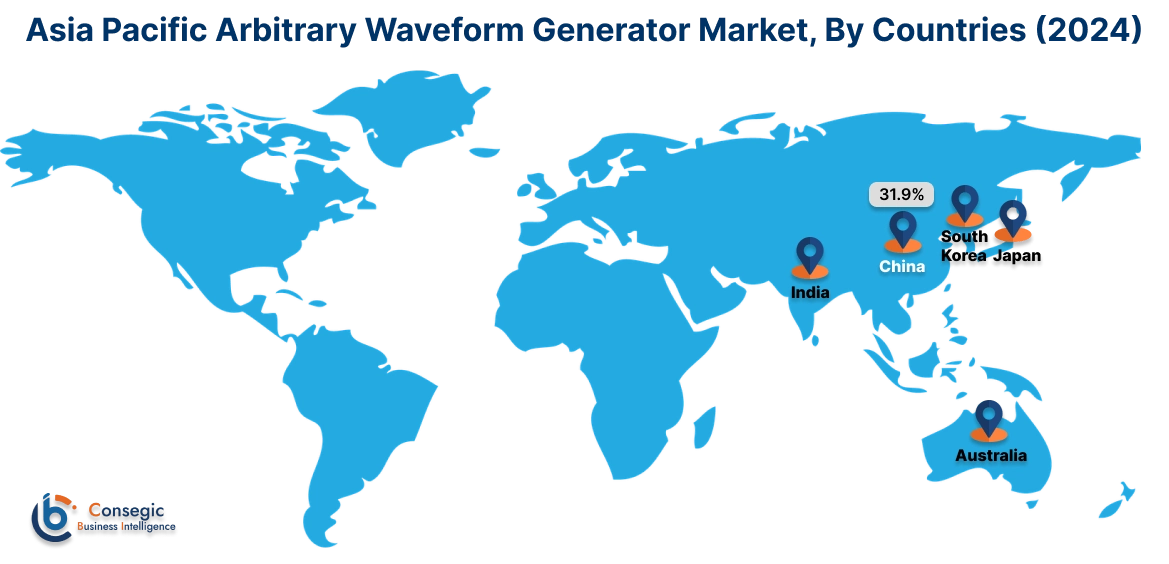
North America is estimated to reach over USD 308.31 Million by 2032 from a value of USD 168.48 Million in 2024 and is projected to grow by USD 178.88 Million in 2025. This region holds a prominent position in the AWG market, driven by substantial investments in research and development across sectors such as telecommunications, electronics, and aerospace. A notable trend is the integration of advanced AWGs in testing and measurement equipment to enhance precision and performance. Analysis indicates that the presence of key market players and early adoption of innovative technologies contribute to the market dynamics in North America.
European countries are pivotal in the AWG market, focusing on technological innovation and the integration of AWGs in automotive and industrial automation applications. A significant trend is the utilization of AWGs in the development and testing of advanced driver-assistance systems (ADAS) and other automotive electronics. Analysis suggests that the emphasis on precision and reliability in industrial processes is driving the adoption of AWGs in this region.
In the Middle East and Africa, the AWG market is influenced by the adoption of advanced technologies in sectors such as oil and gas, telecommunications, and defense. The focus is on utilizing AWGs for equipment testing and signal simulation to ensure operational efficiency and reliability. Analysis suggests that collaborations with international technology providers are facilitating the transfer of knowledge and expertise, aiding in the establishment of local capabilities.
Latin American countries are increasingly recognizing the importance of AWGs in enhancing the quality and efficiency of testing and measurement processes across various industries. A notable trend is the modernization of existing infrastructure to incorporate advanced testing equipment, including AWGs, to meet international standards. The Market trends also indicates that economic development and the pursuit of technological advancement are key factors influencing the market growth in this region.
Top Key Players and Market Share Insights:
The Arbitrary Waveform Generator market is highly competitive with major players providing products and services to the national and international markets. Key players are adopting several strategies in research and development (R&D), product innovation, and end-user launches to hold a strong position in the global Arbitrary Waveform Generator market. Key players in the Arbitrary Waveform Generator industry include -
- Keysight Technologies (USA)
- Tektronix, Inc. (USA)
- Tabor Electronics Ltd. (Israel)
- Rigol Technologies (China)
- Fluke Corporation (USA)
- National Instruments (USA)
- Rohde & Schwarz (Germany)
- Teledyne LeCroy (USA)
- B&K Precision Corporation (USA)
Recent Industry Developments :
Product Launches:
- In November 2024, Siglent introduced the SDG1000X Plus series, offering a 60 MHz output frequency, 16-bit resolution, 1 GSa/s sampling rate, and 8 Mpts arbitrary waveform length for high-precision signal generation. Key features include PRBS output up to 40 Mbps, multi-pulse modes for Double Pulse Testing, and 10 ns rise/fall times for IGBT and MOSFET evaluation. With sweep, burst, modulation capabilities (AM, FM, PSK, PWM), and Webserver remote control, it delivers high-end performance at an affordable cost, optimizing R&D, debugging, and communication system testing.
- In November 2024, Rohde & Schwarz Introduced the R&S RTB 2 Oscilloscope with Enhanced Features. The R&S RTB 2, an upgrade to the R&S RTB2000, expands on its predecessor’s class-leading 10-bit resolution and touchscreen operation with an integrated arbitrary waveform generator (25 MHz) and a 160 Mpts segmented memory. Positioned as a 10-in-1 instrument, it combines an oscilloscope, protocol analyzer, logic analyzer, waveform generator, and more, making it ideal for engineers, educators, and students.
- In March 2024, RIGOL Technologies launched the DG800 Pro and DG900 Pro Series Function/Arbitrary Waveform Generators and the DM858 Series Digital Multimeters, expanding its ultra-portable instrument family. The DG800 Pro & DG900 Pro offer up to 200 MHz output frequency, 1.25 GSa/s sample rate, 16-bit resolution, and 3 ns rise time, integrating noise, pulse, harmonic generation, and modulation in a compact 7” touchscreen unit.
Arbitrary Waveform Generator Market Report Insights :
| Report Attributes | Report Details |
| Study Timeline | 2019-2032 |
| Market Size in 2032 | USD 951.27 Million |
| CAGR (2025-2032) | 8.2% |
| By Technology |
|
| By Channel |
|
| By Frequency Range |
|
| By End-User Industry |
|
| By Region |
|
| Key Players |
|
| North America | U.S. Canada Mexico |
| Europe | U.K. Germany France Spain Italy Russia Benelux Rest of Europe |
| APAC | China South Korea Japan India Australia ASEAN Rest of Asia-Pacific |
| Middle East and Africa | GCC Turkey South Africa Rest of MEA |
| LATAM | Brazil Argentina Chile Rest of LATAM |
| Report Coverage |
|
Key Questions Answered in the Report
What is the size of the Arbitrary Waveform Generator Market? +
The Arbitrary Waveform Generator Market size is estimated to reach over USD 951.27 Million by 2032 from a value of USD 507.91 Million in 2024 and is projected to grow by USD 540.30 Million in 2025, growing at a CAGR of 8.2% from 2025 to 2032.
What are the key segments in the Arbitrary Waveform Generator Market? +
The market is segmented by technology (Direct Digital Synthesis AWG, Variable-Clock AWG, Combined AWG), channel (single channel, dual channel), frequency range (up to 1 GHz, 1 GHz to 5 GHz, above 5 GHz), and end-user industry (telecommunications, electronics, automotive, aerospace & defense, healthcare, others).
Which segment is expected to grow the fastest in the Arbitrary Waveform Generator Market? +
The aerospace & defense segment is projected to grow at the fastest CAGR during the forecast period, driven by increased investments in defense modernization programs and the development of next-generation aerospace systems.
Who are the major players in the Arbitrary Waveform Generator Market? +
Key players in the Arbitrary Waveform Generator Market include Keysight Technologies (USA), Tektronix, Inc. (USA), National Instruments (USA), Rohde & Schwarz (Germany), Teledyne LeCroy (USA), B&K Precision Corporation (USA), Fluke Corporation (USA), Tabor Electronics Ltd. (Israel), Rigol Technologies (China).
